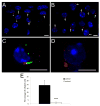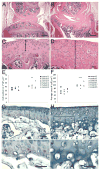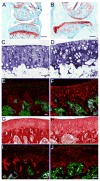Depletion of primary cilia in articular chondrocytes results in reduced Gli3 repressor to activator ratio, increased Hedgehog signaling, and symptoms of early osteoarthritis
- PMID: 22173325
- PMCID: PMC3260404
- DOI: 10.1016/j.joca.2011.11.009
Depletion of primary cilia in articular chondrocytes results in reduced Gli3 repressor to activator ratio, increased Hedgehog signaling, and symptoms of early osteoarthritis
Abstract
Objective: Primary cilia are present in almost every cell type including chondrocytes. Studies have shown that defects in primary cilia result in skeletal dysplasia. The purpose of this study was to understand how loss of primary cilia affects articular cartilage.
Design: Ift88 encodes a protein that is required for intraflagellar transport and formation of primary cilia. In this study, we used Col2aCre;Ift88(fl/fl) transgenic mice in which primary cilia were deleted in chondrocytes. Col2aCre;Ift88(fl/fl) articular cartilage was characterized by histological staining, real time RT-PCR, and microindentation. Hedgehog (Hh) signaling was measured by expression of Ptch1 and Gli1 mRNA. The levels of Gli3 proteins were determined by western blot.
Results: Col2aCre;Ift88(fl/fl) articular cartilage was thicker and had increased cell density, likely due to decreased apoptosis during cartilage remodeling. Mutant articular cartilage also showed increased expression of osteoarthritis (OA) markers including Mmp13, Adamts5, ColX, and Runx2. OA was also evident by reduced stiffness in mutant cartilage as measured by microindentation. Up-regulation of Hh signaling, which has been associated with OA, was present in mutant articular cartilage as measured by expression of Ptch1 and Gli1. Col2aCre;Ift88(fl/fl) cartilage also demonstrated reduced Gli3 repressor to activator ratio.
Conclusion: Our results indicate that primary cilia are required for normal development and maintenance of articular cartilage. It was shown that primary cilia are required for processing full length Gli3 to the truncated repressor form. We propose that OA symptoms in Col2aCre;Ift88(fl/fl) cartilage are due to reduced Hh signal repression by Gli3.
Copyright © 2011 Osteoarthritis Research Society International. Published by Elsevier Ltd. All rights reserved.
Conflict of interest statement
None of the authors have any conflicts to report.
Figures





References
-
- Pedersen LB, Rosenbaum JL. Intraflagellar transport (IFT) role in ciliary assembly, resorption and signalling. Curr Top Dev Biol. 2008;85:23–61. - PubMed
-
- Ishikawa H, Marshall WF. Ciliogenesis: building the cell’s antenna. Nat Rev Mol Cell Biol. 2011;12:222–234. - PubMed
-
- Sharma N, Berbari NF, Yoder BK. Ciliary dysfunction in developmental abnormalities and diseases. Curr Top Dev Biol. 2008;85:371–427. - PubMed
Publication types
MeSH terms
Substances
Grants and funding
LinkOut - more resources
Full Text Sources
Medical

